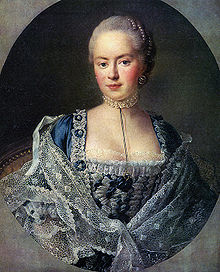You can help expand this article with text translated from the corresponding article in Russian. (August 2010) Click [show] for important translation instructions.
|
Countess Darya Petrovna Saltykova (Russian: Дарья Петровна Салтыкова; née Chernyshyova/Chernysheva (Чернышёва); September 20, 1739 – December 23, 1802)[1] was a Russian lady-in-waiting, socialite and noble and Dame of the Order of St. Catherine's first degree.[2] She was the sister of the lady in waiting Princess Nataliya Petrovna Chernysheva, and in 1769 married to Field Marshal Count Ivan Petrovich Saltykov.[3][1]
Darya Petrovna Saltykova | |
|---|---|
 | |
| Coat of arms |  |
| Born | Darya Petrovna Chernyshyova 20 September 1739 Saint Petersburg, Russian Empire |
| Died | 23 December 1802 (aged 63) Khotilovo, Valdaysky Uyezd, Novgorod Governorate, Russia |
| Nationality | Russian |
| Noble family | Saltykovs |
| Spouse(s) | Ivan Saltykov |
| Issue | Praskovya, Yekaterina, Anna, Pyotr |
| Father | Piotr Chernyshev |
| Mother | Ekaterina Chernysheva |
| Occupation | State Lady |
Life
editShe was the eldest daughter of a diplomat, Count Peter G. Chernyshev, godson (and rumoured son) of Peter the Great, and Catherine Andreevna, daughter of a famous chief of the secret office during the time of Biron, Count Andrei Ivanovich Ushakov.[4] She spent her early life abroad with her father, primarily in England, where she received an excellent education.[5] Upon her return in 1762, she and her sister became known as two of the most learned women in Russia.[6]
In 1762, she was appointed maid of honor to Empress Catherine the Great. She participated in the famous court masquerade of 1766 and at the great amateur theatre performance of 1768, where she was given much attention. After her marriage to Ivan Petrovich Saltykov in 1769, she became a leading figure in the Russian nobility.[7] In 1780–83, she made a trip through Europe with her family, and on their return, her spouse was made governor of Vladimir. In 1793, she was appointed lady in waiting.
She was known for her intellect, and hosted great salons.[3] Her marriage was apparently a happy one, and she and her husband exchanged many letters full of loving remarks.[1]
See also
edit- Filipp Vigel, diarist who wrote about her
References
edit- ^ a b c Engel, Barbara Alpern (2021-08-12). Marriage, Household and Home in Modern Russia: From Peter the Great to Vladimir Putin. Bloomsbury Publishing. ISBN 978-1-350-01449-7.
- ^ Ėrmitaž, Gosudarstvennyj; Netherlands), Nieuwe Kerk (Amsterdam (1996). Catharina: de keizerin en de kunsten : uit de schatkamers van de Hermitage (in Dutch). Waanders. ISBN 978-90-400-9900-7.
- ^ a b Ayres-Bennett, Professor of French Philology and Linguistics Wendy; Ayres-Bennett, Wendy; Sanson, Helena; Sanson, Professor of Italian History of Linguistics and Women's Studies Helena (2021-01-07). Women in the History of Linguistics. Oxford University Press. ISBN 978-0-19-875495-4.
- ^ Русские портреты XVIII и XIX столетий (in Russian). Directmedia. 2013-03-13. ISBN 978-5-9989-7669-8.
- ^ Иванов, Анатолий (2018-09-27). История петербургских особняков. Дома и люди (in Russian). Litres. ISBN 978-5-04-135314-8.
- ^ Russkij archiv: russkij istoričeskij žurnal (in Russian). Stolica. 1891.
- ^ Istoricheskii vi͡estnik (in Russian). 1899.
- Белосельский М. А., Белосельская Н. Г., Белосельская Н. М. Дневник Белосельских — Строгановых // Российский Архив: История Отечества в свидетельствах и документах XVIII—XX вв.: Альманах. — М.: Студия ТРИТЭ: Рос. Архив, 2005. — [Т. XIV]. — С. 71—90.